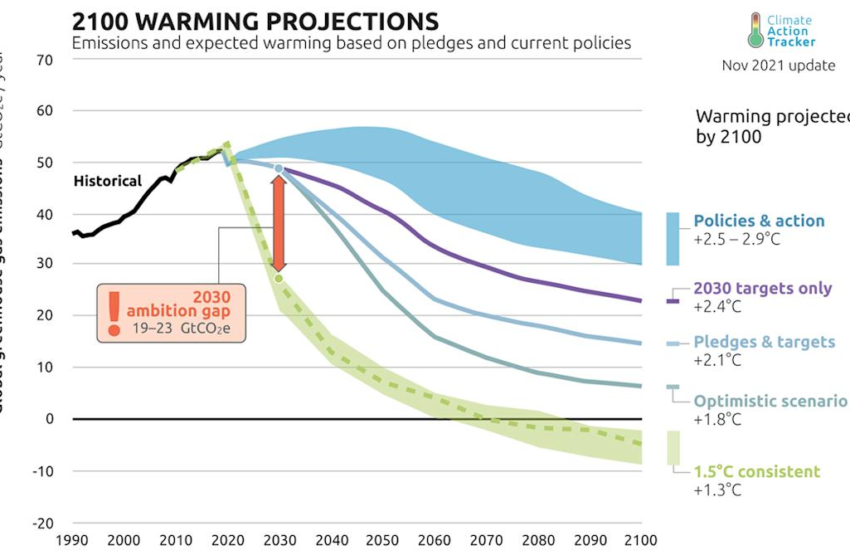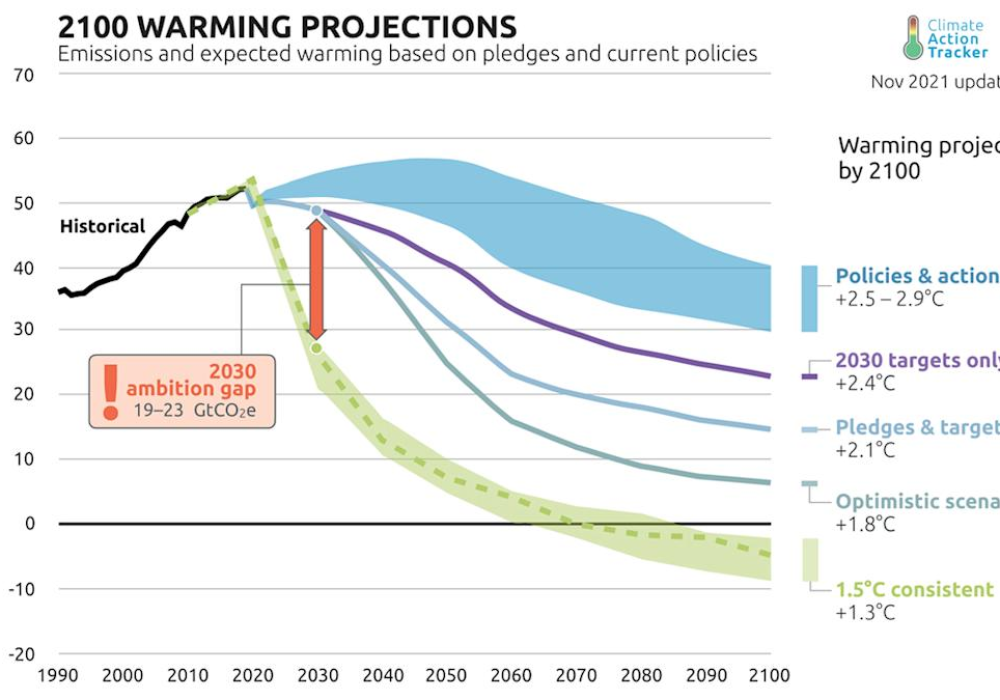GLASGOW, Scotland — The U.N. Climate Change Conference has resulted in a cascade of new pledges from nations large and small to reduce their greenhouse gas emissions, but they still fall short of the goal of keeping global temperatures below 1.5 degrees Celsius (2.7 Fahrenheit) of warming, according to an updated analysis released Tuesday afternoon.
Climate Action Tracker (CAT), an independent scientific analysis, studied every nation’s plan to reduce greenhouse gas pollution and found that the world is on course for between 1.7°C and 2.6°C of warming. The U.N.’s Intergovernmental Panel on Climate Change has warned that in order to avoid the catastrophic effects of climate change, temperature rise needs to be kept below 1.5°C.
By 2100, as estimated by CAT, a collaboration between the research organizations Climate Analytics and the New Climate Institute, warming will reach 2.1°C, an amount of warming that the IPCC has said will lead to devastating weather events and unleash feedback loops such as thawing of permafrost.
“It is clear there is a massive credibility, action and commitment gap that casts a long and dark shadow of doubt” over the national pledges, the CAT report states.
This latest figure, however, is an improvement on the trajectory coming out of the Paris conference of 2015, in which pledges would have led to an estimated 2.7°C of warming by 2100. But it is still short of where climate scientists had hoped to be at the conclusion of the Glasgow conference, also known as COP26, which is due to end on Friday evening.

Get updates on the latest news sent straight to your inbox
The CAT report stands in contrast to a separate estimate issued Thursday by the International Energy Agency projecting that the actions promised in Glasgow could limit warming to 1.8°C.
The reason for the discrepancy is that some national pledges are lacking in sufficient detail to convince some experts that they are really going to be achieved. While the U.S. and China put out thorough projections of how they hope to reach net-zero emissions by 2050 and 2060, respectively, not every nation has been so detailed. For instance, India came forward last week with its first-ever emissions reduction commitment, saying it would reach net-zero emissions by 2070, but it has yet to fill in the details of how and whether that pledge will apply to all greenhouse gases or just carbon dioxide. As a result, Climate Action Tracker discounted India’s pledge and those of other foot draggers such as Russia, Saudi Arabia and Turkey.
It’s also worth noting that the world is not actually assured to reach 2.1°C of warming, much less 1.8°C. Even fleshed-out promises of action tend to be backloaded, and current policies lag even further behind. In fact, based on policies that are currently in place, Climate Action Tracker projects 2°C to 3.6°C of warming by 2100, with the most likely outcome being around 2.7°C.
That’s almost a full degree lower than the 3.6°C of warming that the group projected after Paris, based on policies in place at that time, but it’s also well above the target of 1.5°C of warming. “No single country that we analyze has sufficient short-term policies in place to put itself on track to its net zero target,” the CAT report says.
The United States, which is currently the second-largest emitter, after China, and historically the biggest by far, is a good example of why.
President Biden has pledged to reduce U.S. emissions by at least 50 percent from 2005 levels by 2030. But the Senate hasn’t passed his Build Back Better proposal, which might put the U.S on the path to achieving that. Other policies necessary to fulfill Biden’s promise, such as new rules to limit methane emissions, haven’t yet been instituted and may not survive judicial review.
In general, countries have made bolder pledges of major emissions cuts decades from now, with much more modest actions in the near future.
A U.N. analysis in September estimated that emissions will rise 16 percent by 2030, while the IPCC finds they need to go down 45 percent in that time frame. In order to underscore the necessity of more immediate action, CAT also did a projection of what would happen if the only pledges that are met are those that would occur before 2030.
“This is the critical decade that we are in,” Claire Fyson, co-head of the climate policy team at Climate Analytics, told Yahoo News. “If we don’t halve emissions from now until 2030, we really start to put 1.5[°C] out of reach.”
In recognition of precisely this problem, U.S. climate envoy John Kerry announced on Wednesday evening that the U.S. had reached a joint agreement with China that the world’s most populous nation will join an American-led effort to reduce methane emissions by 30 percent by 2030 and that both nations will make their best efforts to “phase down the use of unabated coal” in this decade as well.
Those newest pledges are not included in the report’s estimates. But China also hasn’t actually yet come up with a plan to achieve either of those goals — it’s just announced its intention to do so. And, as with all promises made in the climate change agreement, there are no penalties for failing to live up to them.
But Kerry’s announcement will eventually be modeled mathematically, and the world will then know just how much closer it has come to avoiding catastrophe — and just how much farther it has yet to go.










